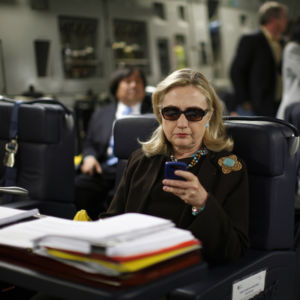In an interview with Ezra Klein published Monday, Hillary Clinton — studious “wonk warrior” of 2016 — made an innocuous little admission: she still needs some tutelage on a major political issue.
This might seem suspect coming from such a seasoned and savvy veteran of American politics, but the presumptive Democratic presidential nominee said she wants more information on the country’s growing ideological division — specifically why, in her loaded words, Republicans “put ideology above everything else.”
“I don’t know all the reasons,” Clinton told Klein, who has plenty of his own thoughts on the matter. “I’m going to wait for a smart political scientist to explain it all to me.”
Luckily for the former secretary of state, InsideSources immediately had someone in mind.
If Clinton really does need a briefing — as distinct, of course, from her own ubiquitous Briefing on social media — she should start with Morris Fiorina, a Stanford professor who “has done extensive research on polarization,” as Klein’s own website noted in February.
InsideSources took the liberty of informing Fiorina about Clinton’s interest, and he was quick to say she’s “talking about a real change that’s occurred in the country.”
Since the 1970s, he explained, the nation’s two prominent political parties have “sorted” themselves ideologically, with each losing the ideological diversity that made overall orthodoxies less rigid.
“The parties used to be big tents,” Fiorina said. “There were conservative Democrats. There were liberal Republicans. … The Republicans are now an ideological right-wing party. The Democrats are now an ideological left-wing party.”
This is a phenomenon that is more pronounced on the right than the left — “Republicans have always been a more ideological party since the 19th century,” the professor said — though it’s significant on both sides.
Addressing Clinton’s question of why these changes have occurred, Fiorina cast polarization in Washington as the result of several factors.
First, campaign financing became more nationalized, with Republicans across the country raising a disproportionate amount of money in Texas while Democrats did so in Hollywood and New York.
These locations and their “donor class” inhabitants are highly ideological, so politicians responded to that.
Yet it’s an oversimplification to credit the political transformation with money entirely.
“We’re recruiting to office a more ideological type of person nowadays,” Fiorina said. “In the old days, a big party machine would come to you and say, ‘You’ve been a good party worker for 20 years, here’s the congressional seat.’ … Now [candidates] come out of the cause groups with their own ideological viewpoints, and they’ve constructed electoral coalitions based on people with strong ideological viewpoints.”
That said, the professor stressed that polarization is “really like that only at the very top.”
“In Congress, there’s no Democrat to the right of any Republican,” he said. “There’s no Republican to the left of any Democrat. … Even when you get down to the level of primary voters, which is who shocked the Republican establishment this year, they’re much less well sorted — much less ideological.”
This year’s big proof of that: Donald Trump.
The presumptive Republican presidential nominee may repel more than half the country with his authoritarianism and targeting of minority groups, but one thing that’s not driving his opposition is any kind of ideological “True Conservatism.”
It’s precisely why commentators like Washington Post columnist George Will and Weekly Standard editor William Kristol grew frustrated as the GOP rejected more doctrinaire conservative candidates in the primary.
“In fact, they’re voting for a guy who doesn’t seem to have any ideology at all,” Fiorina said of Republican voters. “It’s not surprising to somebody who actually looks at what most voters say as opposed to what a few members of the party intelligentsia think.”
Ultimately, that’s the lesson Fiorina said he’d give to Clinton — that when it comes to ideological intensity, no one in Washington is representative of a broader America. “There’s 85 percent of the public that’s just different from the people who operate around Washington,” he said.

